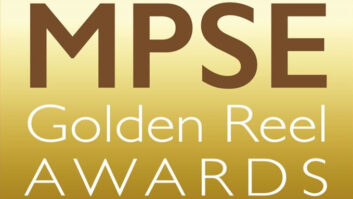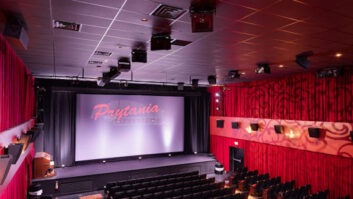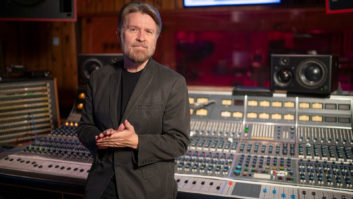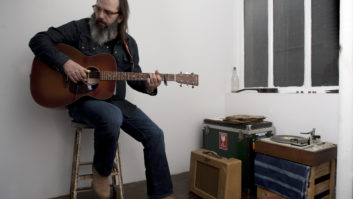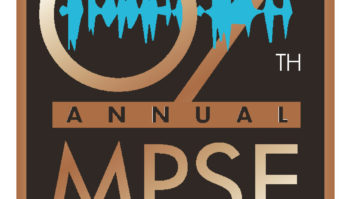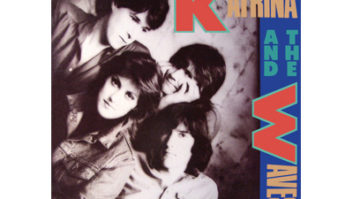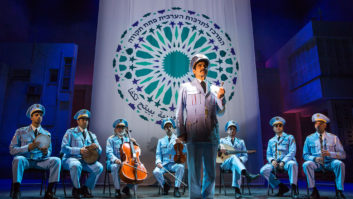A calvacade of Crescent City artists and musicians gathered in Austin to record Sing Me Back Home. From left: Leo Nocentelli, Henry Butler, Raymond Weber, Leo Sacks, George Porter Jr., Ivan Neville and Ray Bardani
Last summer’s two horrific Gulf of Mexico hurricanes — Katrina and Rita — destroyed countless lives and caused unimaginable damage to both the physical and social infrastructure of Louisiana and Mississippi. Talk all you want about rebuilding, New Orleans will never be what it once was, and that is an immense tragedy in itself. The hurricanes also dispersed New Orleans’ sizable population of musicians all over the country like seeds; these suddenly rootless evacuees have struggled to find their way in new cities and towns. But the nation has opened its arms (and ears) to New Orleans’ musicians, and it’s no surprise that in the wake of the hurricane, a number of exceptional music projects featuring the Big Easy’s best have come out. For the musicians, playing music can be like a healing balm, plus all of the CDs have benefited various charities helping the storms’ victims.
In the fall, the Katrina-related releases included Dr. John’s powerful Sippiana Hericane, the live Higher Ground: Hurricane Relief Benefit (both in Jan. ’06 Mix “Cool Spins”) and the exquisite bayou all-star album Our New Orleans 2005. (See “Back Water Blues,” page 136.) Now comes the moving and joyous Sing Me Back Home, featuring a wonderful assortment of some of the Crescent City’s top singers and players — billed collectively as the New Orleans Social Club — captured during one very emotional week in Austin, Texas, last fall.
Sing Me Back Home was conceived by noted New York — based reissue and compilation producer Leo Sacks, whose impressive credit list includes multiple works by The O’Jays, Isley Brothers, Earth, Wind & Fire, Patti LaBelle, Marvin Gaye and many others. When Katrina hit last August, “I was sitting in my new home in Cold Spring Harbor, New York, horrified like everyone else,” Sacks says. “I knew which neighborhoods were being hardest hit because I’ve spent over 25 years going down there, first as a reporter covering Jazz Fest for Billboard and then developing friendships there. As those waters rose, a lot of people knew I had close relationships in New Orleans and started e-mailing me about what was happening there. I couldn’t believe it.”
One thing led to another and eventually, encouraged by Columbia Records president Steve Greenberg, Sacks came up with the idea for Sing Me Back Home, which is being released this month on Burgundy Records, a new Sony/BMG imprint. “Within an hour of envisioning this record,” Sacks says, “I knew who I wanted in the core band and which guests I wanted, too. With Cyril and Ivan [Neville, of the famed New Orleans musical family] having relocated to Austin, I thought that might be a good place to record. Then it became the logistical challenge for Kimball Packard, who manages Henry Butler and John Boutté, to bring everyone into Austin. I thought it was important to make the record as soon as possible, because emotions were so fresh and so raw. We ended up doing it in the second week of October, less than six weeks after the event. A lot of the cats still didn’t really know the state of their homes.
“That was the significance of creating a sort of community in the studio,” Sacks continues. “I think of musicians as healers, and these musicians were in need of healing themselves. It was important that they were all gathered in one place and played some music together, like a real group.”
And what a group it was. The “core band” comprised two members of New Orleans funk kings The Meters — guitarist Leo Nocentelli and bassist George Porter Jr. — Ivan Neville on organ, Butler on piano and the hot young drummer Raymond Weber, who plays in Ivan Neville’s band, Dumpster Funk. The Social Club’s “guests” included Cyril Neville, Dr. John, Irma Thomas and Marcia Ball, Big Chief Monk Boudreaux, The Subdudes, Willie Tee and others.
“I wanted the musical continuity we could achieve with a house band, and I also wanted thematic continuity,” Sacks says. “I didn’t want songs about flooding; I didn’t want songs about rain. I wanted to celebrate the musicality and the spirituality of the old neighborhood because I didn’t know if there would even be an old neighborhood to return to. So I wanted the spirit of the neighborhood bar.”
In all, 13 tracks were cut in a week at Austin’s Wire Recording, with New York — based engineer Ray Bardani handling the technical end of the sessions. “I sort of feel like I sent Ray into battle with a loin cloth and a spear,” Sacks says with a laugh, “because there was so much to be done in such a short period, and it was tough running people in and out of the studio.”
“It was complete craziness to get it all done in seven days,” Bardani agrees, “but where there’s a will there’s a way. We captured the moment and the performances in the way those classic New Orleans records were made.” Right down to recording analog. “Wire has this great API console that was just fantastic with the really good microphones we were using, the MCI JH-24 [recorder] and analog tape,” Bardani offers. “I love the quality of what analog does with real instruments and real musicians.”
Bardani says that Wire is “an interesting room. It’s a medium- to small-sized room and the setup was hard, but once I figured out the layout, I was able to get what I needed, and luckily there was one extra iso booth I was able to use for each artist. It was a tight, intimate setup. We worked fast and got the whole thing on 10 rolls of tape. The rhythm section was so good. And on more than half the record, the vocal performances that were sung with the band were the final performances. The whole thing was really, really raw and alive.
“I didn’t have much time to get sounds,” Bardani adds. “You’ve got all these people waiting to do their songs, and people are flying in and out. George Porter was the musical director, and he did a great job of organizing things and keeping it moving. Each song was done to completion — if there were punches or more vocals to be done, we’d do it right then.”
Bardani kept the miking scheme simple: The drums were miked with Neumann 87s and 67s, a Shure 57 and AKG 414; piano was two 87s; and guitar a 57. A Neumann SM2 stereo mic was used to pick up the sound of the music in the room. For vocals, he used a variety of mics: SM7s for singers with rawer, raspier voices; but also a Sony 800G, a Neumann 47 and an 87. “I put the vocals through Neve 1073 [mic pre’s]; everything else was in the console — Massenburg compressors and the classic [API] EQs. That console sounded really, really good.”
The recording basically went off without a hitch. The house band cooked, and all of the performers seemed particularly inspired. You can hear the raw emotion in the politically charged version of “Fortunate Son” by Ivan Neville. Dr. John — Mac Rebennack — couldn’t make it to Austin, but he sat in long distance from New York for a funkalicious reading of “Walking to New Orleans,” fronting those players he knows so well: “You got all my fellas,” he told Sacks approvingly. (Bardani had recorded Dr. John’s Sippiana Herricane at Bearsville Studios in upstate New York just before the Wire sessions.) Butler sings “Somewhere” from West Side Story, with genuine heartbreak: “There’s a place a place for us…” And Boutté completely reinvents Annie Lennox’s beautiful “Why.” There’s gospel, soul and even a buoyant reggae track: Boudreaux’s, worked up on the spot from a poem the Wild Magnolias leader had written after the floods.
Once the week was done — and all of it was captured on video for a forthcoming DVD release, too — Bardani took the tapes to one of his favorite rooms in Manhattan — Right Track/Sound on Sound — and mixed on the SSL J Series console in the recently renovated Studio C. “The tapes sounded really good — we actually got the sound of the instruments to tape,” Bardani says. “It really didn’t need much — some balancing, a couple of rides and very little EQ. We were very fortunate. Everything seemed to go our way. And mixing there is sort of like home for me.”
Bardani believes the musicians also got a lot out of the project. “This was like an oasis for them,” he offers. “In the middle of what was a very weird time for them, they got to do what they do, which is play music, and keep their minds free. There were intimate, sad moments and moments when everyone had a great time, but in general, everything was always extremely positive.”
“Whenever you gather together New Orleans musicians, you’re going to get that grit and groove and gumbo, and I think that’s what we got,” Sacks adds. “But these were lives in transition, so we also got their uncertainty, their rage, their frustration, their desperation, their sadness, their heartbreak and, in the grandest way, in the spirit of great artistry, their vulnerability. It was an amazing thing to be a part of.”
BACK WATER BLUES
Recording “Our New Orleans”
Another worthy CD to come out of the Katrina tragedy is Our New Orleans 2005 on Nonesuch Records. It’s chock-full of stirring performances by a wide range of top New Orleans musicians, including Dr. John, Allen Toussaint, Irma Thomas, Buckwheat Zydeco, Beausoleil, the Dirty Dozen Brass Band and others. Unlike Sing Me Back Home, which was cut in one studio with a house band (and guests), Our New Orleans was recorded in September and October of 2005 at a variety of studios, using a number of different producers and engineers recording multiple lineups of musicians — also a logistical challenge. Some of the performances are spectacular, too: Toussaint rolling through “Yes We Can Can” (see “Classic Tracks”); Thomas, soulful and gritty on Bessie Smith’s topical “Backwater Blues”; Ry Cooder unleashing one of his greatest slide guitar solos ever on Buckwheat Zydeco’s “Cryin’ the Streets”; pianist Eddie Bo breathing new life into “When the Saints Come Marching In”; Randy Newman fronting the Louisiana Philharmonic for a spellbinding version of “Louisiana 1927”; and on and on. All the musicians, engineers and studios donated their time.
The first sessions took place in Manhattan on September 20 and 21, 2005, following a big Katrina fund-raiser at Madison Square Garden. Working at Avatar Studios, producer Joe Henry and engineer Kevin Killen spent the afternoon of the 20th setting up, and then the band — a number of Henry’s regulars — came in around 7:30 p.m. “We rehearsed the band until about 11,” Killen says, “and we weren’t sure what time Allen [Toussaint] and Irma [Thomas] were going to show up from the concert. They probably came in around 11:30, and then we literally ran down the songs once and started cutting. We were ready to go; we just had to get our vocal levels. Everyone was really revved up.” The next morning, Henry and Killen cut “Yes We Can Can” and “Tipitina” with Toussaint, as well as a track with the Dirty Dozen Brass Band. “It was extremely poignant,” Killen notes. “These musicians didn’t know if their homes had survived, if they even had a home to go back to.” Killen mixed the tracks at Randy Ezratty’s personal facility, Sevonay Sound, which is an ICON D-Command/Pro Tools|HD room. “We kept everything simple,” Killen says. “Our approach was to document what was going down in the room, with a minimal amount of overdubs. I think it turned out really well.”
Meanwhile, over at Clinton Recording (N.Y.), producers Doug Petty and Matt Sakakeeny and engineer Todd Whitelock were tracking the Wild Magnolias and the Perservation Hall Jazz Band for their tracks, and in the weeks that followed, more songs would be cut at Clinton, Avatar, Young Avenue Sound in Memphis, SugarHill in Houston and Avery Fisher Hall at Lincoln Center in New York, with a host of producers: Mark Bingham, Steve Epstein, Joel and Adam Dorn, Nick Spitzer, Ry Cooder and Hal Willner; and many fine engineers — Bill Bennett, Sammy Holbrook, Gene Paul, Jamie Polaski, Larry Rock, Anthony Ruotolo and Drew Vonderhaar.
Of special note, though, is the handful of tracks recorded in October at Dockside Studios in Maurice, La. Miraculously, the studio was spared Katrina’s wrath — which is why engineer Steve Reynolds, of New Orleans’ historic Ultrasonic Studios, gravitated there when his own facility was completely destroyed. “I’m afraid Ultrasonic is ready for the bulldozer,” he says sadly.
“We managed to salvage some of our gear after Katrina and we put it in vans to take down to Dockside because we had a couple of projects to do and [owner Steve Nails] was nice enough to let us work there,” he continues. “But then here comes Hurricane Rita and it was headed right for that area, so we evacuated again and drove around with all this gear, dodging hurricanes for what seemed like the longest time.”
Eventually, Reynolds found his way back to Dockside, and working on Our New Orleans turned into a rare pleasure at a time when he was extremely stressed out from dealing with Ultrasonic’s reversal of fortunes. “In New Orleans, everything was wrecked and my whole world was upside down,” he says. “I was going back and forth trying to salvage things, but when I returned to Dockside, it was so beautiful and nice and peaceful. I’d pull in the gate at Dockside, and it was like the weight of the world was off my shoulders. I needed to do that album. I think we all did.”
